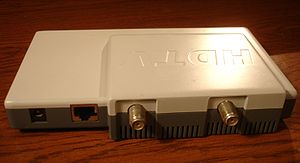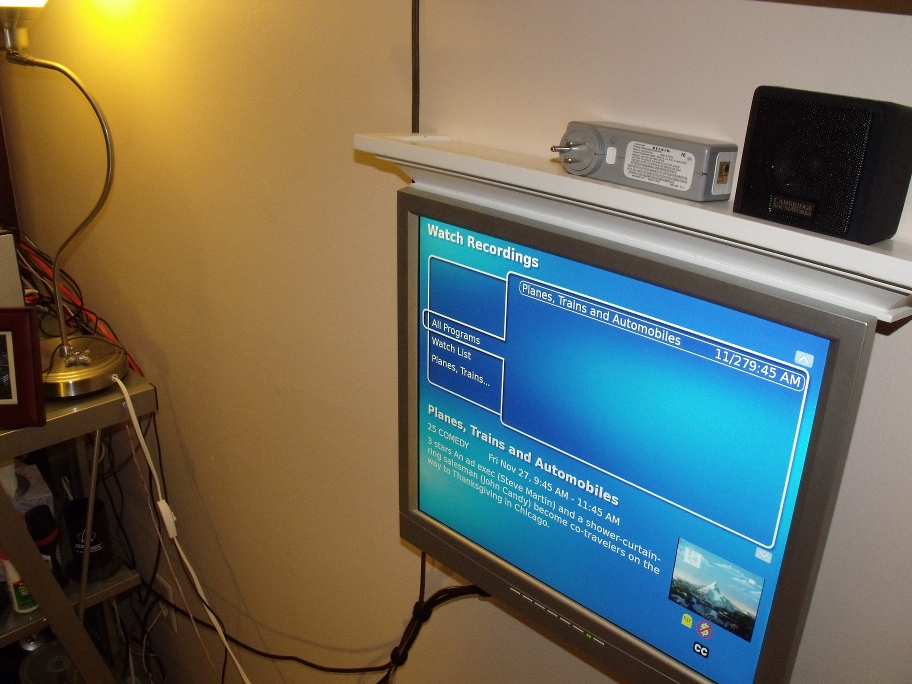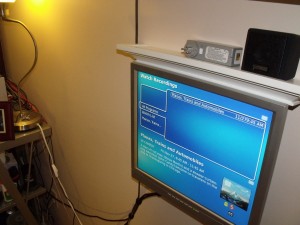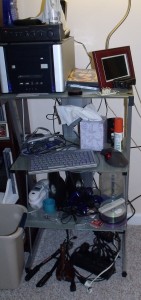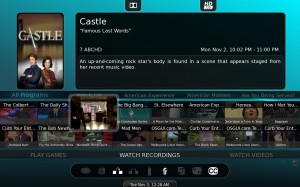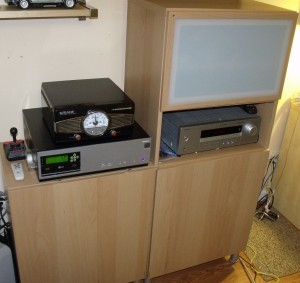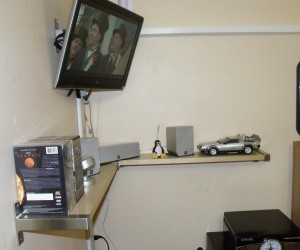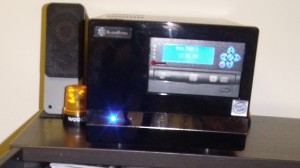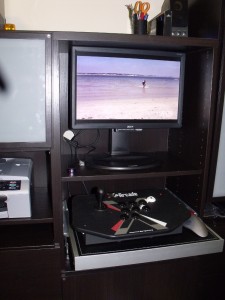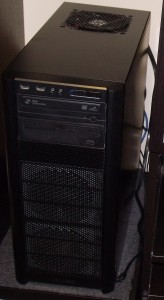 As part of the first of our multipart series, Better Know a MythTV configuration, we profile our MythTV Backend.
As part of the first of our multipart series, Better Know a MythTV configuration, we profile our MythTV Backend.
Our MythTV backend has gone through a lot of changes over the years. The first iteration was in a yellow server case on wheels. We went through a period of overbuilding, and the yellow version of the case was $17, the other colors were all closer to $100. We probably have a picture of that iteration somewhere, and will post it if it is ever found.
The current iteration, pictured left, is an Antec Three Hundred Mid Tower Case. This model is rather unique in that the power supply is at the bottom of the case, as opposed to the top. It was the first tower we ever had with that configuration. As you can see in the picture, there is space for 2 120mm fans in the front, right in front of the hard drive bays, and there is a washable filter in front of them. The top has a 140mm fan. and the back another 120mm fan. We used the quietest fans we could, but it can be heard as a low hum in the room. There is room for a side exhaust fan, which was have not installed.
There have been several generations of interior boards since the beginning. The current is an Asus board. The thing runs 24 hours a day, so we opted for one which, according to reviews, had high quality capacitors and good build quality. The computer runs headless, so we opted for a board with an onboard graphics card. There was no need for a discrete one when it was never used.
The processor is an AMD Athlon 64 X2 5600+. At the time of purchase, it was the highest speed AMD processor we could get that used 65W of power. Everything else used 95W or above. For our next generation, we are considering going to a higher speed, but low power Intel processor, but we’ll see where the market is when we decide for replacement.
A powerful processor is not inherently necessary for a MythTV backend. If you have a video encoding device that does its own encoding with significant use of the CPU, you could run the thing off of a low-power processor. But if you want to transcode some of your files into a smaller format for long-term storage, it helps to have something that can handle the extra load.
The system has 8GB of RAM, which is overkill, but the RAM was relatively cheap, and easier to install than the processor. Then we get to the hard drives. There are two 500GB drives in a mirroring RAID. So, in the event of failure, the system can go on. Only a small amount of the space is needed for the operating system and the MythTV database. The rest stores important data, our music collection, and any long-term video files.
To store active uncompressed recordings, we are currently taking advantage of MythTV’s storage group function. It distributes the recordings between two Green drives. These drives spin at 5400RPM and are supposed to be more power efficient. One is a WD 1TB and the other a Samsung 1.5TB. Because of the design of MythTV’s storage groups, files can be moved between any of the directories named in the storage group without pausing the server.
This means if one of the drives shows pre-failure, which we recently had, we can move the files to the other drive and take one of them out of commission. We also ensured that the system has an ESATA connector, which would allow us to plug in an external drive and add it to the storage group to keep the system running if we need the extra space.
The computer has two optical drives, and this was originally planned to allow for having one drive used to burn a rewriteable DVD on a time schedule, which would be rotated manually out of the system and placed in backup. That never happened, and at some point in the future, one of them will be replaced by a blu-ray burner, to allow for larger optical backups.
Support for firewire channel changing is what convinced us to dive in fully into MythTV. Originally, the output of the cable box fed into a PVR-150 capture card. Then, firewire recording became more reliable, so the PVR-150 was mostly retired. Finally, when the cable company changed its software and both capture and channel changing became unreliable, we switched to the tried and true infrared channel changing and high-definition capture using the Hauppauge HD-PVR box.
As having only one cable box and HD-PVR would mean we couldn’t resolve any conflicts, we have a Silicondust HDHomerun hooked directly into the cable lines, tuning any unencrypted channels, which are mostly local and public access stations. And, in the event cable goes down entirely, we hooked a line to the old roof antenna, disused for over a decade, and hooked it into an inexpensive card that could tune Over-the-Air digital. Digital Broadcast is often higher quality than the same channel over the cable lines, due to compression, so if you are an HD purest, you probably want to try to supplement your cable with digital broadcast.
The backend, as referenced before, also downloads video programming via MiroBridge and integrates it into the recording menus. This may change as time passes. Speaking of software, our system runs a non-graphical installation of the latest edition of Fedora, currently 12. We periodically update the system after a new release of Fedora has been released long enough for us to feel comfortable upgrading.
We upgrade by making a backup, then moving all the data from the RAID to the recording drives, wiping the RAID drives, installing the new OS, and moving the data back. The whole process takes a few hours, and most of it is waiting for the installation or copy to complete. Most configuration is already setup and just needs to be restored.
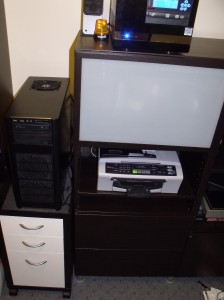 Here’s a wider shot of the system. Last year, we redecorated the room in early Ikea. The backend, codenamed Freshpond, sits on a rolling file cabinet called a Mikael. There is a sound baffling like material under it to prevent scratching, which is a cut piece of Ikea drawer liner. One of these days we may switch to a desk blotter or such for aesthetic reasons. There are both pros and cons to having the system off the ground. Next to it, you can see a printer and one of the two MythTV frontends currently operating. Behind that glass door is the HD-PVR and the cable box.
Here’s a wider shot of the system. Last year, we redecorated the room in early Ikea. The backend, codenamed Freshpond, sits on a rolling file cabinet called a Mikael. There is a sound baffling like material under it to prevent scratching, which is a cut piece of Ikea drawer liner. One of these days we may switch to a desk blotter or such for aesthetic reasons. There are both pros and cons to having the system off the ground. Next to it, you can see a printer and one of the two MythTV frontends currently operating. Behind that glass door is the HD-PVR and the cable box.
More on the first frontend, seen in the picture, in Part 2.
Like many, we constantly think about refinements to the system to improve it. Sometimes this is new hardware, sometimes consolidating redundant systems, and sometimes software improvements. For example, in addition to the once hourly check for new internet video from the RSS feeds we monitor to import, a separate job also searches for audio podcasts we have told it to monitor and downloads them.
Ultimately, like any hobby, maintaining the system takes on a passion. But for those of you looking to build a system, it really doesn’t take that much day to day effort and the basic setup is simple. More advance concepts…well, you can always ask someone who has done it. Like us, for example. Comments welcome.
